12.) Discuss morphological diversity of the bacteria with sufficient examples ?
12.) Discuss morphological diversity of the bacteria with sufficient examples ?
Bacteria is a prokaryotic, unicellular organism. Bacteria are found everywhere, they are the most abundant living organisms. They can thrive in extreme conditions like hot springs, snow, deep ocean, where it is difficult for other organisms to live.
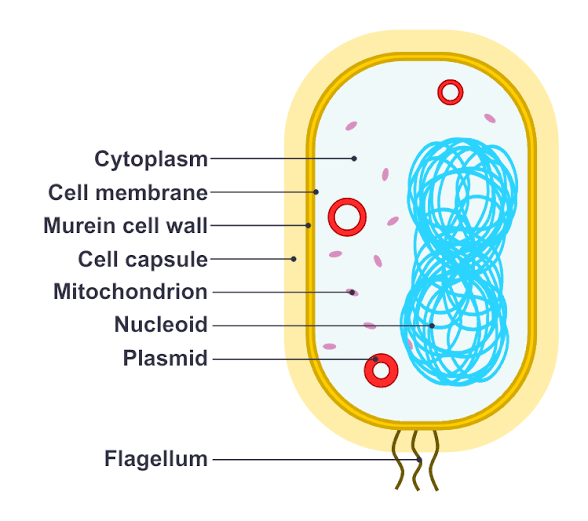
Salient features of bacteria are the following:
- Unicellular prokaryotic cell
- Present in different shape, size and arrangement
- The cell lack nucleus and membrane-bound cell organelles
- Bacterial DNA is found in the cytoplasm and not packaged to form chromatin as in eukaryotic cell
- Bacteria cell is 10 times smaller than the human cell
- The diameter of a bacteria cell is ~1µm (10-6 m)
- The outer covering of a bacteria cell is the cell wall, which is rigid and provides structural integrity
- The bacteria cell wall is made up of peptidoglycan or murein
- Different shapes of bacteria cell are the characteristic feature of a bacteria species
- Bacteria cells may contain external appendages like cilia, flagella, etc.
- Bacteria can be photoautotrophs, chemoautotrophs or parasites
Morphology of a Bacteria Cell
Morphology or shape of a bacteria cell is the most distinguished property of a bacteria. It is the characteristic property of a particular species.
Morphology of bacteria cell not only tells the shape but also decides its pathogenicity. Morphological traits of a bacteria cell are an important factor in its adaptability and evolution. There are many features like motility, mode of nutrition, that are affected by the shape of bacteria.
The bacterial cell wall is made up of peptidoglycan (murein), which is a polymer of sugars, alternating N-acetylglucosamine (NAG) linked to N-acetylmuramic acid (NAM) and amino acids peptide chain. Change in the configuration of the polymer and its thickness is responsible for the varied morphology and shape of a bacteria cell.
Read more: Motile and Non-motile Bacteria Examples
Size of Bacteria
The size of bacteria can be averaged to 2 micrometres with a diameter of 0.5 micrometres. Bacteria are known to display a wide variety of size and shapes. They are about one-tenth the size of a eukaryotic cell.
Different shapes of bacteria
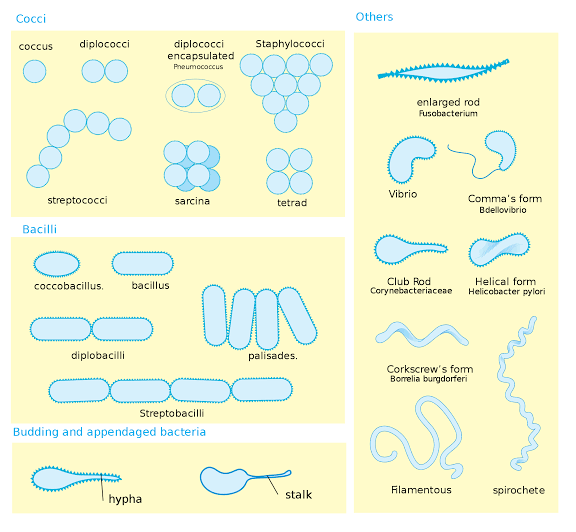
- Spherical- Cocci
- Rod-shaped- Bacilli
- Spiral bacteria
- Comma shaped- Vibrio
1. Spherical- Cocci:
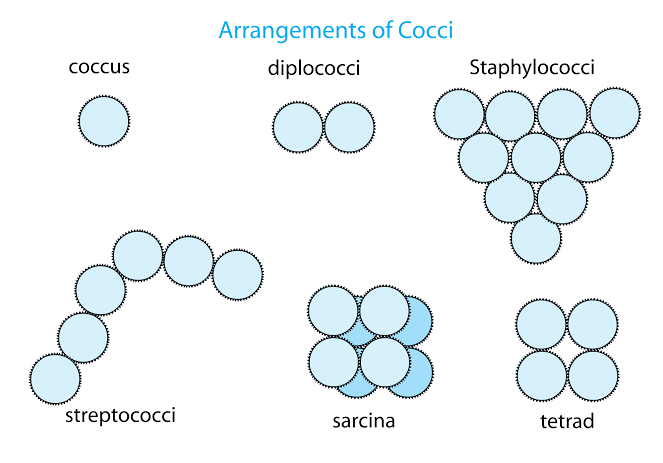
Cocci can be single or multiple in a group of 2, 4, 8, etc. Cocci bacteria can be round, oval or elongated or bean-shaped.
- The cell wall of coccus shaped bacteria may be gram-positive with thick peptidoglycan layer, or gram-negative with the thin peptidoglycan cell wall
- The cells do not separate after cell division. The plane of cell division changes the shape of the bacteria
According to the arrangement of cells, cocci bacteriaare subdivided into various subtypes:
- Monococcus: bacteria exist as a single spherical cell
- Diplococcus: Cells are arranged in pairs after cell division.Examples of diplococcus bacteria are:Gram-negative bacteria- Neisseria spp, Moraxella catarrhalisGram-positive bacteria- Streptococcus pneumoniae, Enterococcus spp, etc.
- Streptococcus: the cocci are joined in a plane and arranged in a chain pattern. These are non-motile, aerobic and gram-positive bacteria that cause many diseases.Examples of streptococci are Streptococcus mutans, Streptococcus pyogenes, Streptococcus bovis, Streptococcus agalactiae, etc.
- Tetrads: Tetrads are arranged in a group of 4 cells. The cell division occurs in two different planes.Examples of tetrads cocci bacteria are Micrococcus spp, Pediococcus, etc.
- Staphylococcus: Cells are arranged in an irregular cluster, which looks like grapes. This is due to the division in three planes.Examples of staphylococcus are staphylococcus aureus, Staphylococcus haemolyticus, etc.
- Sarcinae: Sarcinae bacteria are anaerobic gram-positive bacteria. They occur as a group of 8 cells. It is found in the family Clostridiaceae. It is found in the large intestine and skin.Examples of sarcinae are: Clostridium maximum, Sarcina auranatica, Sarcina ventriculi, Clostridium maximum, Microcioccus luteus, etc.
2. Rod-shaped- Bacilli:
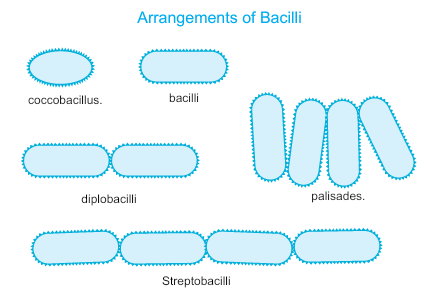
- Bacilliform bacteria are found in many different taxonomic groups of bacteria
- Bacilliform bacteria can be gram-positive, e.g. Actinomyces, Clostridium, Bacillus or gram-negative bacteria, e.g. Escherichia, Klebsiella, Salmonella, Streptobacillus, etc.
- Bacteria of genus Bacillus are gram-positive, rod shaped bacteria
- They are obligate aerobe or facultative anaerobic bacteria
- They can form endospores and live for years as dormant and resistant to heat, radiation and disinfectants
- They can survive extreme heat and temp as high as 420 ℃
- They are the most abundant bacteria and found everywhere
- Mostly non-parasitic, free-living species
- Two parasitic and pathogenic bacillus species are Bacillus anthracis causing anthrax and Bacillus cereus, which causes food poisoning
Based on the arrangement of rod shaped cells, bacilli are classified into various types:
- Bacillus: Single unattached cell, that looks like a rod.Examples are Bacillus cereus, Salmonella enterica, etc.
- Diplobacilli: Two rods are attached to each other and found in pairs after cell division.Examples are Moraxella bovis, Klebsiella rhinoscleromatis, etc.
- Streptobacilli: Due to cell division in one plane, bacilli are arranged in a chain. Genus Streptobacillus contains gram-negative, aerobic or facultative anaerobic bacteria.Examples are Streptobacillus moniliformis, Streptobacillus felis, etc.
- Coccobacilli: These are short compared to other bacilli and oval in shape, they appear like a coccus.Examples are Chlamydia trachomatis, Haemophilus influenzae, Gardnerella vaginalis, etc.
- Palisades: The bacilli after cell division bend and therefore arranged in a palisade, fence-like structure. Example: Corynebacterium diptheria
3. Spiral bacteria:
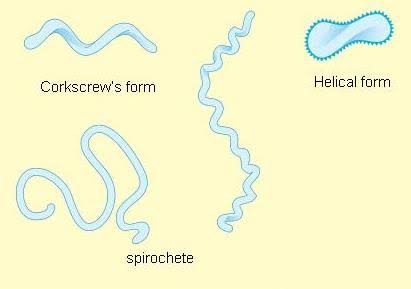
Based on the thickness, flexibility and motility of the cell, they are further divided into two types:
- Spirillum: These are gram-negative, rigid bacteria having external flagella.Examples are Spirillum, Campylobacter jejuni, Helicobacter pylori, etc.
- Spirochete: These bacteria are spiral, thin and flexible. They have internal periplasmic flagella. These are pathogenic species that cause various serious diseases.Examples are Leptospira, Treponema pallidum, etc.
4. Comma shaped- Vibrio:
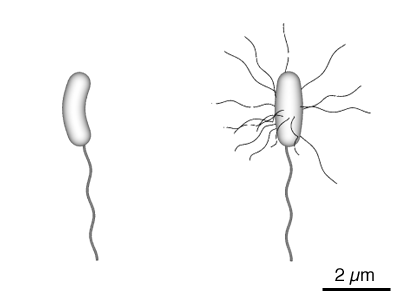
- These are mostly gram-negative bacteria
- They are known to cause various foodborne diseases
- Vibrio sp are facultative anaerobes and have 2 chromosomes which replicate independently
Examples are Vibrio cholerae, Vibrio parahaemolyticus, etc.
Other than the main 4 shapes, the bacterial cell possess various different morphology namely
- Filamentous: have a long filamentous structure. Example: Candidatus savagella
- Star-shaped: resemble a star. Example: Stella humosa, Stella vacuolata
- Rectangular: these are box or rectangular shaped. Example: halophilic bacteria such as Haloarcula vallismortis
- Pleomorphic: these have ability to change their shape and size due to various external factors like pressure, environmental stress, etc. Example: Mycoplasma pneumonia, Mycoplasma genitalium
- Appendaged: they are also known as budding bacteria. They can be non-motile or motile with flagella. Example: Hypomicrobium, Rhodomicrobium
- Trichome: trichomes are a chain of vegetative cell. This is often covered with slimy sheath as in cyanobacteria. Example: Thiothrix nivea
- Lobed: these have a lobed structure and mostly found in hot and volcanic springs. They are flagellated and have an irregular shape. They are acidophiles and thermophiles. Example: Sulfolobus acidocaldarius, Sulfolobus solfataricus
- Fusiform: these are spindle-shaped, bulged in the middle and the end is tapered. Example: Fusobacterium necrophorum
- Stalked: a stalk develops at one end of bacteria due to asymmetrical cell division. Example: Caulobacter crescentus
- Sheathed: bacteria cell is covered with sheath. They are found in water. Example: Leptothrix, Clonothrix
Comments
Post a Comment